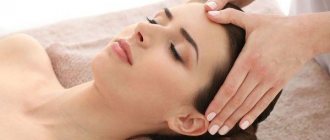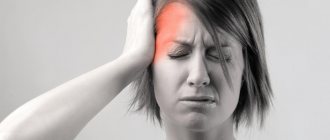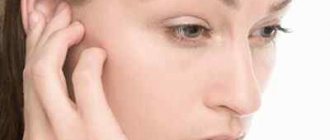Each of us has experienced a terrible headache at least once in our lives. One of its causes is hemicrania, or, more simply, migraine. This disease is neurological and most often occurs in women. Medical scientists have not yet found a way to cure this disease, but there are many methods in the world to relieve headaches. Exercise for migraines can help achieve positive results in relieving headaches.
With the help of exercises, you can relieve existing pain and prevent its attacks, because when performing yoga asanas, internal tension is relieved, muscles relax, stress and tension go away.
Yoga helps with migraines
Impact principle
Modern pharmacology offers a wide range of drugs that almost instantly eliminate pain and spasms. But this only masks the problem and prevents the organs from sending signals. Moreover, medications have side effects that lead to other problems.
A headache is a kind of signal that tells a person that the body is not working properly. Very often, spasms appear due to overstrain of the neck and back muscles. This is a common problem for modern people who spend most of the day sitting. Yogic exercises help relieve tension, normalize blood pressure and prevent headaches.
REFERENCE! Asanas and breathing practices eliminate the effects of stress, which also causes headaches. Yoga therapy focuses on gradual relaxation and slowing down. Complexes of various poses help improve the supply of oxygen to the brain and reduce the likelihood of migraines.
Kinesitherapy
Kinesitherapy is a method that aims to integrate the mental and physical aspects of the human body through movement and self-awareness. Through the acquired ability to express oneself through movement, this therapy aims to provide a way to gain self-confidence. Since all movements are controlled by the mind, they give it the opportunity to manifest itself externally.
Kinesitherapy offers the patient the opportunity to express themselves, create space for creativity, and gain relief from unexpressed, suppressed emotions. This brings relaxation, improves the health and social capabilities of the patient, and therefore helps eliminate migraines.
Preventive asanas
The main yoga asanas, which allow you to avoid pain or significantly reduce the number of attacks, are aimed at relaxing and healing the areas of the body that provoke pain.
You should start the exercises by warming up your neck. Sit comfortably on a chair or on the floor with your legs crossed and your arms freely at your side. Raise your right hand above your head and reach your left ear. Slowly tilt your head to the right side. Apply light pressure with your hand and resist it with your head. After 60 seconds, straighten up and do the same on the other side.
IMPORTANT! First of all, attention is paid to the neck, spine, shoulder girdle and forearms.
Dog pose or dolphin pose helps release tension in your forearms and stretches your upper back. It is important to keep your breathing free and not strain your neck. Start on your knees, hip-width apart, with your hands on the floor and your wrists shoulder-width apart. Take a breath. Lower your elbows to the floor, slowly lift your hips and exhale. The heels should be parallel to each other. It is not necessary to place them on the floor if the stretch does not allow you to do so. Relax your neck, look at your feet and hold the pose for 3-5 breathing cycles.
Camel pose. Get on your knees, bend back, rest your palms on your feet. Do not push your hips forward; they should be perpendicular to the floor. Don't strain your neck, breathe freely. Hold the pose for 3-5 breathing cycles. This asana helps open the duct of the vertebral arteries and prevents headaches due to tension in the neck.
Exercise effectiveness
These three exercises must be performed regularly to avoid headaches. They are quite simple, accessible to a person with any level of training.
- The first exercise relaxes the forehead area, engages the legs and arms, and relieves tension from the neck muscles. To perform it, you will need a chair, the back of which must be placed against the wall and covered with a blanket. Stand facing a chair and press your palms against the wall, raising them just above your shoulders. Leave your feet hip-width apart. Step back until your arms are parallel to the floor. Rest your forehead against the back of the chair and lightly pull the top of your head toward the wall. If you are bothered by severe muscle tension in your legs, bend your knees slightly. Hold the pose for 1-2 minutes and slowly come out of it. Calm your breathing in Mountain Pose (Tadasana).
- The second exercise is similar to the inverted dog pose. Don't change your chair position. Place your palms on the seat and step back until your arms and torso are in line. Reach the top of your head towards the wall, stretching your neck. After 1-2 minutes, smoothly exit the pose and perform Tadasana again.
- To perform this asana, you must use a special block. It helps calm the mind. Get on all fours with your heels touching the wall. Place a block on the mat and assume the Downward-Facing Dog position. Place the upper part of the forehead on the brick. Breathe freely, do not strain your throat. After 1-2 minutes, relax in child's pose.
Reference! Yoga also helps eliminate and prevent the manifestation of unpleasant symptoms of hemorrhoids.
What to do if your head already hurts?
If you still have a headache or feel it approaching, try Viparita Karani asana. In this case, it should be performed not in its full form, but in a slightly modified form.
- lay a rug or blanket on the floor, sit sideways to the wall and bend your legs;
- lie on your back, bend your legs and place a sandbag on your feet, then straighten your legs, pressing them as much as possible against the wall;
- place the second bag of sand over your eyes and place your arms along your body;
- Relax completely and do not move for 15-20 minutes.
Yoga for migraines and headaches - emergency help
When a headache appears unexpectedly and ruins all your plans, you can use the simple advice of experienced yogis who know the secrets of quick relaxation and restoration of vitality and energy. To relax and relieve pain you need to:
- Remove the unpleasant effects of bright light or sound. Darkness is the best way to distract attention from problems with heart rate and blood pressure. In the dark, the body and the body relaxes along with it and tunes into the right mood.
- Lie on the floor with your legs up. At the slightest clouding of consciousness, dizziness, or tinnitus, you need to take a position in which the attack will subside faster, bringing consciousness back to normal.
- Pull yourself together and switch your attention so as not to develop anxiety and panic.
If you have constant, painful headaches that prevent you from concentrating on work or other processes, you should not hesitate to visit a doctor. After all the necessary examinations, yoga classes will bring harmony and peace into your life, improving your internal state.
Gaining self-control and complete calm helps relieve a severe attack of pain. Only in this way, excluding bright light and strong noise, can you try, with concentration, to redirect the pain.
You can use this technique - sharply raise both legs vertically onto the wall, or place some contrasting object (cool or soft, etc.) on your feet.
Attention from the head switches to the legs, and the pain begins to recede. Yoga cannot be considered a panacea; it is often combined with other methods of preventing and treating migraines and other types of headaches.
Breath work
Nadi Shodhana helps cleanse the energy channels of the body. To do this, sit with your back straight and relax. Use your thumb to close your right nostril and begin to inhale slowly through your left. After this, exhale even more slowly. Repeat the same with the other nostril. Do the practice for 1 minute.
Sheetali is a cooling breath that allows you to feel relief from headaches.
Sit cross-legged. Stick your tongue out of your mouth a little and roll it into a “tube”. Begin to slowly inhale through it and exhale through your nose, closing your mouth. Repeat 3-4 times without haste. REFERENCE! Pranayama or breathing exercises in yoga provide relaxation, relieve tension, improve blood circulation and calm the nervous system. They help get rid of headaches caused by stress or an immobile lifestyle.
Contraindications
It is better not to practice asanas as a pain reliever for those who have cardiovascular diseases or cancer. They are also contraindicated for colds and in the postoperative period. First, consult a doctor to rule out serious illnesses, only then start doing gymnastics.
You need to be very careful if you are pregnant, for whom yoga provides special sets of exercises with an instructor. During menstrual periods, it is also better for women to avoid activities that involve the back and hips.
Respect your feelings, do what you can.
It is important to know about contraindications to performing yoga exercises:
- cardiac diseases;
- cold;
- malignant tumors.
Yoga has a number of contraindications; exercises should not be used if:
- cardiovascular diseases;
- colds, viral infections;
- tumor formations.
In order to exclude the development of serious illnesses, it is important to consult a specialist and find out the cause of migraine, as well as contraindications to the use of yoga. If nothing serious is revealed as a result of the examination, you can safely use the knowledge to combat overexertion and fatigue, which cause frequent headaches.
With the help of yoga, you can prevent the occurrence of new attacks of pain and migraines, as well as the development of neuralgia.
Yoga is contraindicated for people:
- those suffering from cardiovascular diseases;
- having tumors;
- caught a cold;
- with elevated body temperature.
For such ailments, you should visit a doctor; in other cases, yoga exercises are not dangerous.
Whatever the cause of the headache, before you buy yourself a pack of tablets, it is worth remembering that any medicine only temporarily eliminates the symptom, but not the cause. This method seems to be the most effective and simple, but in the end it does more harm than useful things.
This is a good reason to think about whether the “game is worth the candle” and take a different path. The realization that yoga is the best alternative to any medicine has helped millions of people around the world not only get rid of headaches, but also improve their health in general.
Exercises should not be done by people who have heart disease or malignant tumors. They also do not engage in this practice during colds and acute diseases of internal organs.
There are special exercises for pregnant women. Asanas are selected accordingly for children, which are easy to perform without the risk of harm to health.
Poses for Migraine Relief
Migraine is a neurological disease that is often accompanied by severe headaches. If you feel an attack coming on, perform Viparita Karani. But if you haven’t had time to do this, then try the practice of relaxation.
Legendary meditation course without payment We recommend! The most popular meditation course for beginners in Russian. More than 100 thousand people have already learned to meditate. Try it yourself. Read more.
Shavasana (dead man's pose) is suitable for this . It involves conscious relaxation of the body, relieves tension and restores strength. To complete this you will need 3 blankets and a bandage.
Fold the blanket into strips - one 30 cm wide, the other 70 cm long. Place one of them under the back area. Sit with your back to this stand with your knees bent. Wrap your head in a bandage or some kind of bandage.
Smoothly, supporting yourself with your hands, lie down. Your shoulders should only lightly touch the blanket under your head. Place your hands relaxed at a short distance from your body, palms up.
Raise your knees slightly and “throw” them onto the floor in a relaxed manner; do the same with your pelvis and chest. Close your eyes, take a deep breath in and out, and relax.
Feel each part of the body and relax it: start with the feet, move up the legs, then pay attention to the pelvis, back, abdomen, chest, hands and forearms.
It is very important to relax your neck, back of your head and face. Keep your breathing calm and observe the sensations in your body. ATTENTION! Audio accompaniment for performing guided Savasana.
After complete relaxation, try to let go of thoughts and remain in the pose for at least 5 minutes. When finished, bend your knees, turn over onto your right side, lie there for a while and slowly rise up.
Meditation
Meditation is considered the foundation of yoga. Relaxation will give an effective result in a difficult fight against migraine. Daily meditation will relieve nagging pain, give new strength and increase the thirst for life.
It is advisable to meditate while sitting, in the “lotus position” (who can) or simply in Turkish. Hands lie palms up. Closing your eyes, mentally turn your gaze to the middle of your forehead. You need to stay in this position for about 20 minutes. In this state, you should get rid of anxious and restless thoughts.
This relaxation improves blood circulation in the upper body, as a result of which migraines recede.










